The x86 Power Myth Busted: In-Depth Clover Trail Power Analysis
by Anand Lal Shimpi on December 24, 2012 5:00 PM ESTWebXPRT
I also included Principled Technologies' new HTML5/js web test suite WebXPRT in our power analysis. Like the rest of the tests, Intel already outperforms NVIDIA here but does so with lower power consumption. A big part of the advantage continues to be lower power consumption on the GPU rail, surprisingly enough.
TouchXPRT
As our first native client test, we turned to PT's TouchXPRT 2013. As there is no "run-all" functionality in the TouchXPRT benchmark, we had to present individual power curves for each benchmark. The story told here is really more of the same. On the CPU side, Intel is able to deliver better performance at lower power consumption. On the GPU side, performance is good enough for these tasks but once again, is delivered at lower power consumption.


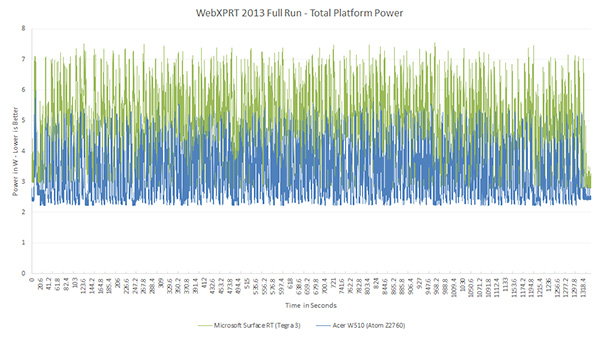

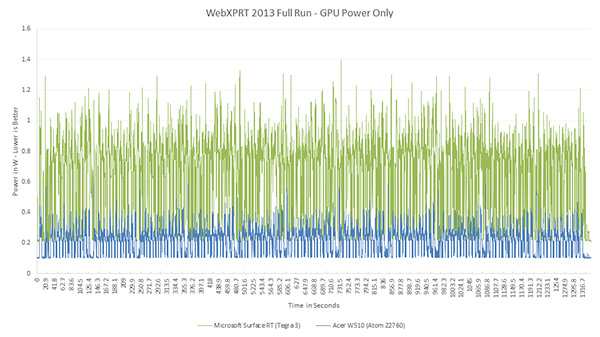
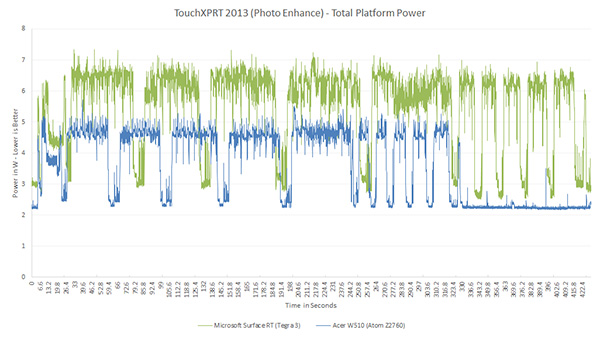
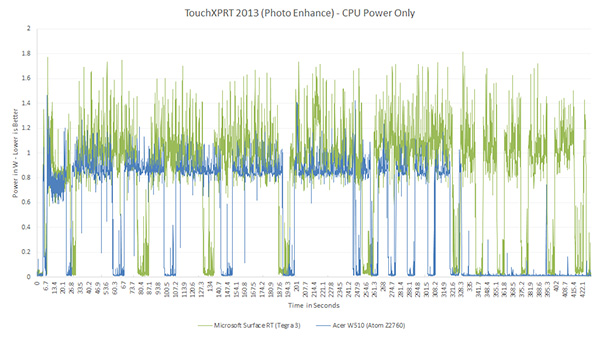
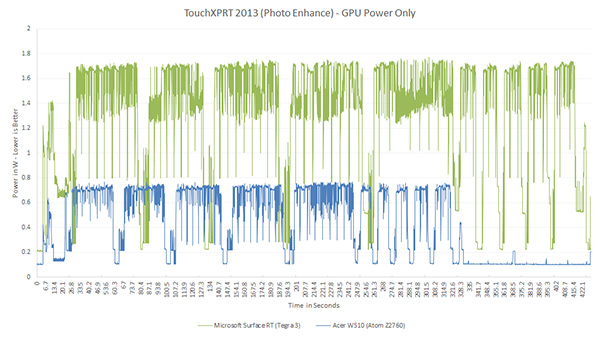

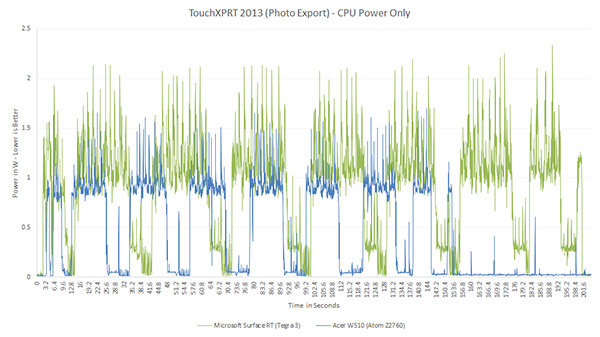
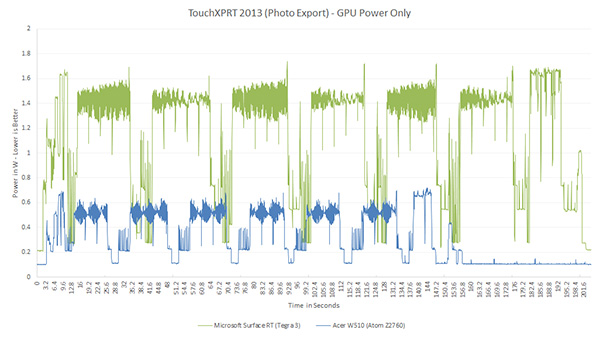
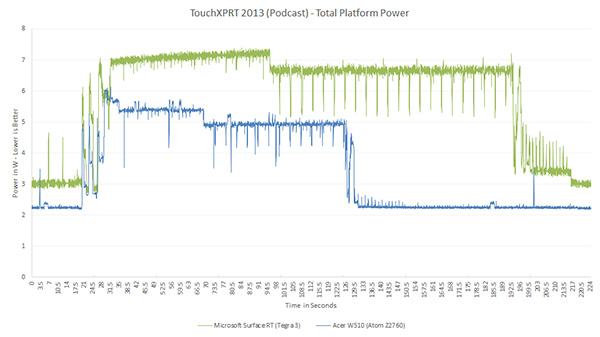

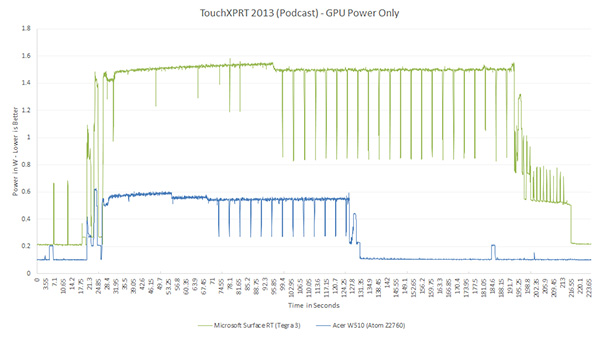
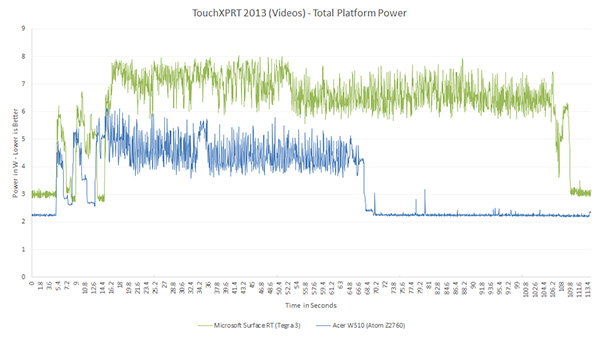
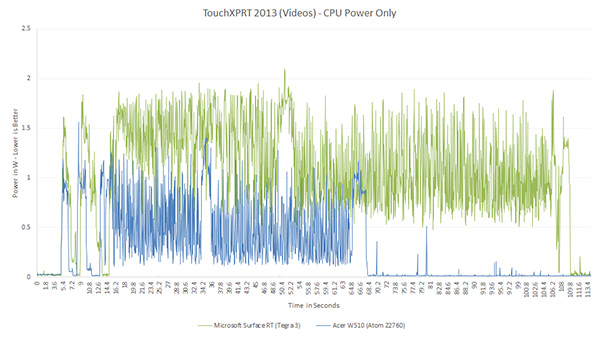
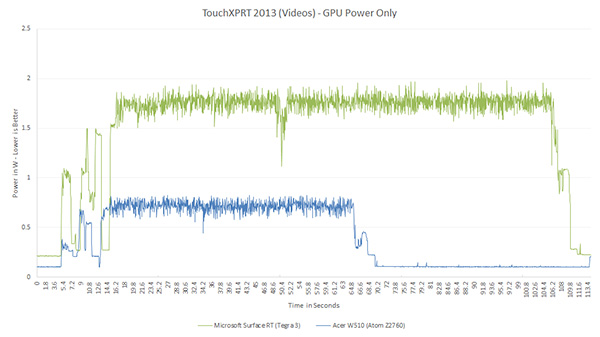








163 Comments
View All Comments
karasaj - Monday, December 24, 2012 - link
All they need to do is either put intel HD graphics (Haswell) or license a better gpu from Imagination, I imagine. Although ARM (Samsung?) have really been developing better GPUs lately, they seem to be catching up.jeffkibuule - Tuesday, December 25, 2012 - link
They've already stated they will be integrating a variant of their Intel HD 4000 GPU in their next-generation Atom SoC, the only question is how many Execution Units and what kind of power profile their will be targeting.With Intel, the question isn't so much about performance, but maximizing profits. If they build an Atom SoC that's so great and also cost competitive with other ARM chips, who would buy their more expensive Core CPUs? This is one reason why I believe that the Atom and Core lines will eventually have to merge, just like how the Pentium and Pentium M lines had to converge into the original Core series back in 2006 (oh, how the irony in history repeating itself).
lmcd - Tuesday, December 25, 2012 - link
It's more likely a variant of the 2500, which won't be enough. 4k doesn't even beat the 543MP3 does it?jeffkibuule - Tuesday, December 25, 2012 - link
There haven't really been any comparisons of mobile and smartphone GPUs yet. We'll have to wait for 3DMark for Windows 8 to get our first reliable comparison.wsw1982 - Tuesday, December 25, 2012 - link
I think it depends, 16 543MP3 cores should beat the 4K :) Single core 543MP3 is not better than 545.mrdude - Wednesday, December 26, 2012 - link
It's also a matter of TDP, though. The ARM SoCs pack a lot of punch on the CPU side but with often better GPU performance at an equal footing with respect to TDP (sub-2W for smartphones and ~sub-5W for tablets).As much as Intel wants to pound home the point that x86 is power efficient, it's an SoC and therefore a package deal. Intel still suffers from the lopsided design approach, dedicating far too much die space to the CPU with the GPU an afterthought. If you look at the more successful and popular/powerful ARM SoCs, it tends to be the other way around. A balanced approach with great efficiency is what makes the Snapdragon S4's such fantastic SoCs and why Qualcomm has now surpassed Intel in total market cap. The GPU is only going to become more and more important going forward due to PPI increasing drastically. At least for Apple, they've already reached a point where they're required to spend a huge portion of the die to the GPU with smaller, incremental bumps in CPU performance.
This really seems like Intel is shoehorning their old Atom architecture into a lower TDP, saying: "Look! It's efficient! Just don't pay any attention to the fact that we're comparing it to a 40nm Tegra 3 and don't you dare do any GPU benchmarks." These things are meant for tablets, are Intel not aware just how much MORE the GPU matters? Great perf-per-watt (maybe), but that's all for nothing if the SoC sucks.
somata - Monday, December 31, 2012 - link
As others have said, it'll be nice once we can do proper comparisons between tablet/notebook/desktop GPUs, but in the meantime just consider the peak shader performance of each:Intel HD 4000 - 16(x4x2) @ 1.3GHz - 333 GFLOPS
Intel HD 3000 - 12(x4) @ 1.3GHz - 125 GFLOPS
PowerVR SGX 543MP4 - 16(x4) @ 300MHz - 38.4 GFLOPS
PowerVR SGX 554MP4 - 32(x4) @ 300MHz - 76.8 GFLOPS
The PowerVR numbers are based off of Anand's analysis. Obviously not exactly a fair comparison, but clearly Intel's mainstream integrated GPUs are substantially more powerful than any current PowerVR design. Of course that shouldn't be a surprise given the TDP of each platform.
p3ngwin1 - Tuesday, December 25, 2012 - link
there are already smartphones with 1080P displays and Android tablets with even high resolutions :)coolhund - Tuesday, December 25, 2012 - link
Plus the Atom is not OoO, IO is known to use much less power. Plus the OS is not the same.Sorry, but for me this comparison is nonsense.
tipoo - Monday, December 24, 2012 - link
I'll be very interested to read the Cortex A15 follow up. From what I gather, if compared on the same lithography the A15 core is much larger than the A9, which likely means more power, all else being equal. It brings performance up to and sometimes over the prior generation Atom, but I wonder what power requirement sacrifices were made, if any.I'm thinking in the coming years, Intel vs ARM will become a more interesting battle than Intel vs AMD.